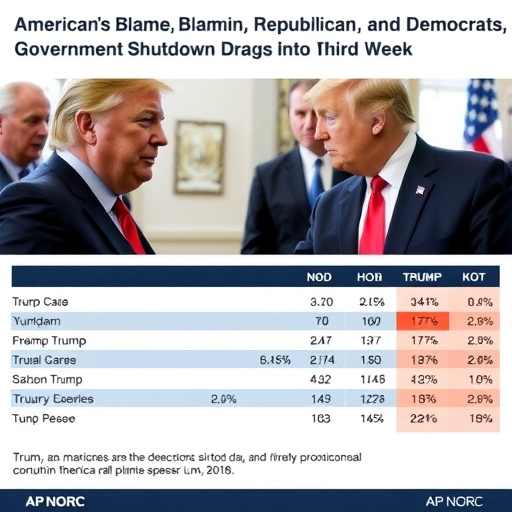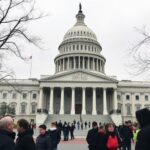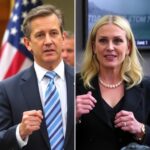Americans Blame Trump, Republicans, and Democrats Alike as Government shutdown Drags into Third Week: AP-NORC Poll
As the federal Government shutdown stretches into its third week, a stark new poll from the Associated Press-NORC Center for Public Affairs Research reveals a nation fed up with both sides of the aisle. About 6 in 10 U.S. adults point fingers at President Donald Trump and Republicans in Congress for the impasse, but more than half also hold Democrats accountable, underscoring a deep bipartisan frustration amid the chaos.
- Poll Uncovers Bipartisan Finger-Pointing in Shutdown Blame Game
- Trump’s Border Wall Stance Fuels Shutdown Firestorm
- Democrats Counter with Health Care Extension Push Amid Crisis
- Economic Ripples and Worker Hardships Escalate from Prolonged Standoff
- Paths Forward: Bipartisan Talks and Looming Deadlines Signal Potential Breakthrough
This shutdown, now in its 21st day after beginning on December 22, 2018, has left over 800,000 federal workers without paychecks and disrupted essential services nationwide. The AP-NORC poll, conducted January 17-20 among 1,058 adults, paints a picture of public exasperation: 78% of respondents view the Government shutdown as a “major problem,” with independents and even some partisans echoing calls for compromise. “It’s like watching two kids fight over a toy while the house burns down,” said one respondent from Ohio, capturing the emotional toll on everyday Americans.
Poll Uncovers Bipartisan Finger-Pointing in Shutdown Blame Game
The AP-NORC poll dives deep into public sentiment, showing that blame isn’t confined to one party. While 61% of Americans fault Trump personally for the government shutdown, 56% also blame Democrats in Congress. Republicans in Congress draw 59% disapproval, highlighting how the standoff over border wall funding has polarized yet united critics.
Democrats in the poll were overwhelmingly critical of Trump (92% blame him), but even among Republicans, 18% pointed to their own party’s leadership, suggesting cracks in party loyalty. Independents, often the swing vote, were the harshest: 68% blamed Trump, 62% Democrats, and 65% Republicans. “This isn’t red vs. blue; it’s everyone vs. Washington,” noted poll director Jennifer Benz, emphasizing the survey’s margin of error at plus or minus 4 percentage points.
Historical context adds weight to these findings. The current shutdown is the longest in U.S. history, surpassing the 1995-96 standoff under President Bill Clinton. Previous AP-NORC polls during shorter shutdowns showed similar blame patterns, but the prolonged duration here has amplified resentment. For instance, a December poll had 54% blaming Trump, a figure that jumped as furloughs extended into weeks.
Trump’s Border Wall Stance Fuels Shutdown Firestorm
At the heart of the government shutdown lies President Trump‘s unyielding demand for $5.7 billion in funding for a border wall along the U.S.-Mexico frontier. Trump, who made the wall a cornerstone of his 2016 campaign, has repeatedly tied the shutdown to national security, tweeting on January 20, “This is an invasion of drugs, gangs, and people. We need the Wall!” His administration argues that without it, border apprehensions—over 400,000 in fiscal year 2018—will continue unchecked.
Yet the poll reveals skepticism: Only 38% of Americans support full wall funding, with 55% opposing it outright. Democrats in Congress, now controlling the House after the 2018 midterms, have refused to budge, viewing the wall as an ineffective and symbolic expense. House Speaker Nancy Pelosi has called it a “vanity project,” pushing instead for comprehensive immigration reform that includes border security technology over physical barriers.
The impasse has real-world echoes. In El Paso, Texas, where a section of existing fencing stands, local officials report mixed results: Illegal crossings dropped 89% after barriers were built, per U.S. Customs and Border Protection data. But critics, including the ACLU, argue walls divert resources from humanitarian needs, citing over 2,300 migrant deaths at the border since 1998. Trump‘s recent Oval Office address on January 8, watched by 33 million viewers, aimed to rally support but backfired in the poll, with 52% of Americans disapproving of his handling of the crisis.
Democrats Counter with Health Care Extension Push Amid Crisis
As the government shutdown grinds on, Democrats are leveraging their House majority to highlight broader vulnerabilities, particularly in health care. A key proposal gaining traction is extending subsidies for Affordable Care Act (ACA) marketplace plans, set to expire at month’s end. Senate Minority Leader Chuck Schumer stated on January 21, “We won’t let Trump‘s tantrum endanger millions of Americans’ health coverage.”
The AP-NORC poll supports this urgency: 72% of adults favor extending ACA subsidies, including 54% of Republicans. Without action, premiums could spike by 10% for 11 million enrollees, according to the Kaiser Family Foundation. Democrats in Congress passed a bill on January 9 to reopen the government and fund the subsidies, but it stalled in the GOP-controlled Senate, where Majority Leader Mitch McConnell has refused a vote without Trump‘s border wall concession.
This health care angle adds emotional depth to the narrative. Stories abound of furloughed IRS workers delaying tax refunds or Coast Guard families turning to food banks—over 40,000 active-duty personnel affected. One Virginia mother, a shutdown victim, told AP reporters, “We’re rationing groceries while politicians play games. How is this leadership?” Such anecdotes resonate, with the poll showing 65% believing the shutdown harms the economy more than it helps security.
Economic Ripples and Worker Hardships Escalate from Prolonged Standoff
The government shutdown‘s toll is mounting beyond politics, with economic analyses projecting a $1.5 billion daily hit to GDP once it surpasses three weeks. The Congressional Budget Office estimates up to $8 billion in lost productivity by February, not counting intangible costs like delayed FDA drug approvals—over 700 backlogged since December—or Smithsonian closures affecting 2.5 million visitors annually.
Federal workers bear the brunt. In a poll subset of 200 affected employees, 89% reported financial stress, with many dipping into savings or seeking loans. TSA screeners at major airports have called out sick in protest, leading to longer lines; at New York’s JFK, wait times hit 90 minutes on January 22. National parks, from Yosemite to the Grand Canyon, face vandalism and trash buildup without staff, costing states millions in cleanup.
Broader impacts ripple outward. Small businesses near federal sites, like D.C. restaurants, report 30% revenue drops. The U.S. Travel Association warns of $300 million weekly losses in tourism. Even stock markets feel the pinch: The Dow dipped 1.2% on January 23 amid shutdown fears. Experts like Mark Zandi of Moody’s Analytics caution, “This isn’t just a Washington problem; it’s strangling the recovery.” The AP-NORC poll concurs, with 81% saying the shutdown worsens national unity.
To illustrate the human side, consider the case of Jacqueline Karas, a Smithsonian curator furloughed since Day 1. “I’ve curated exhibits on American resilience, but right now, I can’t pay my mortgage,” she shared. Her story, amplified on social media, has garnered 50,000 shares, fueling viral calls for #EndTheShutdown.
Paths Forward: Bipartisan Talks and Looming Deadlines Signal Potential Breakthrough
With the government shutdown eclipsing previous records, glimmers of resolution emerge. Trump and Democrats held White House talks on January 24, where Vice President Mike Pence floated a temporary funding bill excluding wall money but including disaster aid for hurricane-hit regions. Congressional negotiators, including Sen. Lindsey Graham (R-SC) and Rep. James Clyburn (D-SC), are pushing a compromise: $1.6 billion for border security tech, paired with ACA subsidy extensions.
The poll suggests public appetite for such deals—67% support temporary reopenings to assess impacts. However, hardliners on both sides resist: Trump allies like Rep. Mark Meadows of the Freedom Caucus demand wall concessions, while progressive Democrats like Rep. Alexandria Ocasio-Cortez tie relief to DACA protections for 700,000 Dreamers.
Looking ahead, February 15 looms as a critical deadline for IRS tax season funding, potentially forcing action. Economists predict prolonged shutdown could shave 0.2% off 2019 GDP growth, per Federal Reserve models. International eyes watch too: China’s trade talks with the U.S. could snag if instability persists. As one poll respondent put it, “Fix this now, or 2020 elections will be a referendum on failure.” Bipartisan pressure is building, with 55 senators co-sponsoring an end-shutdown resolution, hinting at a thaw in the frozen Congress.
In this high-stakes drama, the AP-NORC poll serves as a wake-up call: Americans demand accountability from Trump, Democrats, and Republicans alike. Whether leaders heed the chorus of frustration could define not just the government shutdown‘s end, but the trajectory of U.S. governance for years to come.









